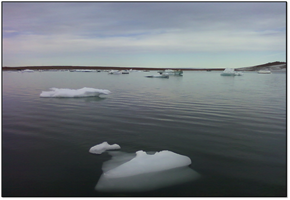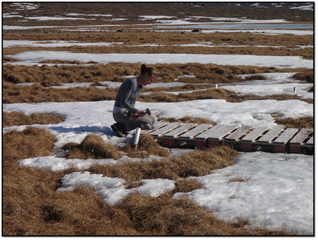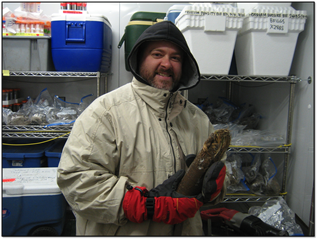|
|
 Arctic landscapes are changing rapidly. The “greening” and “shrubification” of the Arctic are well documented, wide-spread phenomena (Jia et al. 2003, Bunn and Goetz 2006, Tape et al. 2006). As the Arctic has warmed, particularly in winter, it has set off a cascade of processes that drive biotic change and a suite of positive feedback loops that act through C storage and trace gas release, albedo, latent heat exchange, snow distribution, permafrost stability, and both animal and human use of the tundra (Chapin et al. 2005, Sturm et al. 2005). Arctic landscapes are changing rapidly. The “greening” and “shrubification” of the Arctic are well documented, wide-spread phenomena (Jia et al. 2003, Bunn and Goetz 2006, Tape et al. 2006). As the Arctic has warmed, particularly in winter, it has set off a cascade of processes that drive biotic change and a suite of positive feedback loops that act through C storage and trace gas release, albedo, latent heat exchange, snow distribution, permafrost stability, and both animal and human use of the tundra (Chapin et al. 2005, Sturm et al. 2005).
The vegetation change, however, is driven by belowground feedbacks between plants and microbes (Chapin et al. 2005, Sturm et al. 2005, Weintraub and Schimel 2005).  Plants regulate microbes by controlling substrates available, while microbes regulate plant community composition and productivity by controlling nutrient supply (Epstein et al. 2000), which also controls decomposition rates (Mack et al. 2004) and carbon balance (McKane et al. 1997). The microbial system, therefore, may play a key role in regulating the functioning of the overall Arctic System. Predicting changes in the pattern of tundra biogeochemistry therefore requires a better understanding of the distribution of key groups of microbes and the factors that regulate their distribution and functioning. However, these are very poorly understood. Plants regulate microbes by controlling substrates available, while microbes regulate plant community composition and productivity by controlling nutrient supply (Epstein et al. 2000), which also controls decomposition rates (Mack et al. 2004) and carbon balance (McKane et al. 1997). The microbial system, therefore, may play a key role in regulating the functioning of the overall Arctic System. Predicting changes in the pattern of tundra biogeochemistry therefore requires a better understanding of the distribution of key groups of microbes and the factors that regulate their distribution and functioning. However, these are very poorly understood.
Microbial distribution and function are immediately regulated by: 1) the nature of substrates being supplied to the soil (i.e. plant communities), and 2) the direct environmental stresses on arctic microorganisms.  We have almost no understanding, however, of how these factors operate or interact (Zhou et al. 1997, Gunde-Cimerman et al. 2003). We are only just developing any understanding of bacterial distribution among tundra communities at a single site, and we have no appreciation of how they are distributed around the Arctic. Are their distributions a function of plant communities and thus, the nature of substrates provided? Or alternatively, are microbes regulated by their ability to tolerate the freezing conditions of winter? What are the ecosystem consequences of microbial acclimation to low temperature, in terms of C and N fluxes? To what extent to these altered fluxes regulate plant available nutrients? The answers to all these questions are currently unknown. We have almost no understanding, however, of how these factors operate or interact (Zhou et al. 1997, Gunde-Cimerman et al. 2003). We are only just developing any understanding of bacterial distribution among tundra communities at a single site, and we have no appreciation of how they are distributed around the Arctic. Are their distributions a function of plant communities and thus, the nature of substrates provided? Or alternatively, are microbes regulated by their ability to tolerate the freezing conditions of winter? What are the ecosystem consequences of microbial acclimation to low temperature, in terms of C and N fluxes? To what extent to these altered fluxes regulate plant available nutrients? The answers to all these questions are currently unknown.
Through a combination of field and laboratory work using chemical, genetic, and proteomic analyses, we will evaluate the balance of substrate and winter survival abilities in regulating microbial distribution in the Arctic and will evaluate the ecosystem consequences of the physiological costs associated with functioning through the long, cold, dark winters of the Arctic.
|
|
| |
 |
|
.
|
|
|

 Arctic landscapes are changing rapidly. The “greening” and “shrubification” of the Arctic are well documented, wide-spread phenomena (Jia et al. 2003, Bunn and Goetz 2006, Tape et al. 2006). As the Arctic has warmed, particularly in winter, it has set off a cascade of processes that drive biotic change and a suite of positive feedback loops that act through C storage and trace gas release, albedo, latent heat exchange, snow distribution, permafrost stability, and both animal and human use of the tundra (Chapin et al. 2005, Sturm et al. 2005).
Arctic landscapes are changing rapidly. The “greening” and “shrubification” of the Arctic are well documented, wide-spread phenomena (Jia et al. 2003, Bunn and Goetz 2006, Tape et al. 2006). As the Arctic has warmed, particularly in winter, it has set off a cascade of processes that drive biotic change and a suite of positive feedback loops that act through C storage and trace gas release, albedo, latent heat exchange, snow distribution, permafrost stability, and both animal and human use of the tundra (Chapin et al. 2005, Sturm et al. 2005).  Plants regulate microbes by controlling substrates available, while microbes regulate plant community composition and productivity by controlling nutrient supply (Epstein et al. 2000), which also controls decomposition rates (Mack et al. 2004) and carbon balance (McKane et al. 1997). The microbial system, therefore, may play a key role in regulating the functioning of the overall Arctic System. Predicting changes in the pattern of tundra biogeochemistry therefore requires a better understanding of the distribution of key groups of microbes and the factors that regulate their distribution and functioning. However, these are very poorly understood.
Plants regulate microbes by controlling substrates available, while microbes regulate plant community composition and productivity by controlling nutrient supply (Epstein et al. 2000), which also controls decomposition rates (Mack et al. 2004) and carbon balance (McKane et al. 1997). The microbial system, therefore, may play a key role in regulating the functioning of the overall Arctic System. Predicting changes in the pattern of tundra biogeochemistry therefore requires a better understanding of the distribution of key groups of microbes and the factors that regulate their distribution and functioning. However, these are very poorly understood.  We have almost no understanding, however, of how these factors operate or interact (Zhou et al. 1997, Gunde-Cimerman et al. 2003). We are only just developing any understanding of bacterial distribution among tundra communities at a single site, and we have no appreciation of how they are distributed around the Arctic. Are their distributions a function of plant communities and thus, the nature of substrates provided? Or alternatively, are microbes regulated by their ability to tolerate the freezing conditions of winter? What are the ecosystem consequences of microbial acclimation to low temperature, in terms of C and N fluxes? To what extent to these altered fluxes regulate plant available nutrients? The answers to all these questions are currently unknown.
We have almost no understanding, however, of how these factors operate or interact (Zhou et al. 1997, Gunde-Cimerman et al. 2003). We are only just developing any understanding of bacterial distribution among tundra communities at a single site, and we have no appreciation of how they are distributed around the Arctic. Are their distributions a function of plant communities and thus, the nature of substrates provided? Or alternatively, are microbes regulated by their ability to tolerate the freezing conditions of winter? What are the ecosystem consequences of microbial acclimation to low temperature, in terms of C and N fluxes? To what extent to these altered fluxes regulate plant available nutrients? The answers to all these questions are currently unknown. 